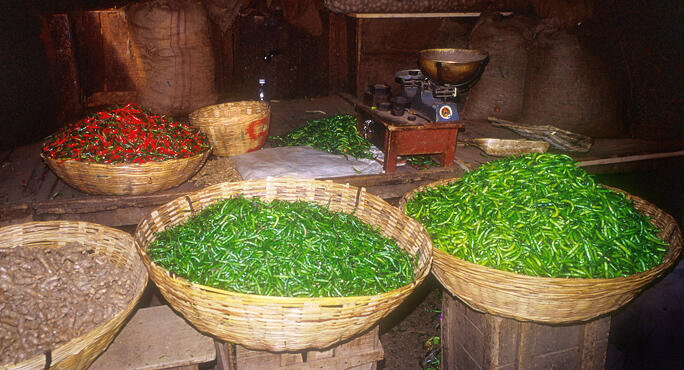Botanical Name
AKA
If chiles had a song, it would be Heat Wave. If chiles had a movie, it would be Towering Inferno. If chiles performed a native ritual, they would firewalk. If chiles had a heroine, it would be Joan of Arc. Chiles are burning, blazing, sizzling, searing, on fire, hot, hot, hot.
Chile, the Plant
The chile plant is any of several members of the genus Capsicum, about which there has been much dispute and hot debate over the past 300 years. For our purposes, the chile plant is any of five domesticated species of Capsicum, including Capsicum annum, C. frutescens, C. pubescens, C. chinense, and C. baccatum. These species are descendant of over twenty wild species from tropical and subtropical America, originally found in Bolivia, Mesoamerica and Amazonia. All chiles may have originated from a single source, which some experts believe lies in central Bolivia.
The chile plant is a cultivated perennial shrub as short as 12 inches and rarely taller than 2 metres in height, with profuse, asymmetrical light to dark green leaves, small white or purple flowers, and bearing numerous fruits (chiles) of varying size, color and heat. Almost all chiles are green when immature, though some appear white or yellow or purplish. As a rule mature chiles are red, orange, or yellow. This coloration is due to the presence of a red carotenoid known as capsanthin. The shape of chiles varies greatly. The cayenne variety is long and slender and tapered. The cherry variety looks like a small tomato. The jalapeno variety is smooth and bulbous, while the penis pepper looks like a flaccid glans penis.
The heat of chili peppers is measured by the Scoville Heat Index in multiples of 100 units, from the bell pepper at zero Scoville units to the incendiary Habanero at 300,000 Scoville units. That’s hot! But even the hellish habanero has been surpassed by hotter peppers. The Mexican Red Savina variety of habanero has been tested at 575,000 Scoville units. You would expect this extreme heat to secure a position for the Red Savina as the world’s hottest pepper by a wide and uncomfortable margin. But specialists at Assam’s Defense Research Laboratory reported in August 2000 that India’s Naga Jolokia variety of Capsicum frutescens measures an astonishing 855,000 Scoville units. Will there ever be an end to the pain?
Chile Reverie
The Devil’s own vegetable woos the faithful with a seductive religious experience of chapped and burning lips, a spanked and swollen tongue, a mouth that aches with heat, a searing swallow, a boiling gastric churning, sweat drooling down a sizzling brow, the face and brain flush with hot pounding blood, and a wave of pain-quenching endorphins, which surge in the brain like firemen in a city aflame. In the grip of chili fever, the mind swoons in ecstatic pain, like an acolyte with stigmata.
Why do people subject themselves to this blazing ordeal? It’s the pleasure, brain cells swimming in endorphins, giddy and happy-faced on natural opiates. Herein lies the secret to chiles. People don’t eat super hot peppers because they like the sensation of mucous membranes being seared raw. Chile aficionados like the evil little vegetables because they cause the brain to produce profuse amounts of endorphins, morphine-like substances that can alter your mental state significantly, if you get enough going at once.
The Blazing Capsaicinoids
The substances that make chilis hot are a group of natural oleoresins called capsaicinoids. These substances account for between 0.1% - 1% of the total composition of a chile pepper. Of these compounds the hottest is capsaicin, which tips the scales at over 16,000,000 Scoville Heat Units. Capsaicin and di-hydrocapsaicin together make up 80-90% of the capsaicinoids found in peppers. The sensation of burning produced by the capsaicinoids is physiologically similar to the sensation of burning caused by heat or fire. The capsaicinoids open cell membranes in a way that allows calcium ions to flood into cells. This triggers a pain signal that is transmitted to the next cell. This same process occurs when cells are exposed to excessive heat.
The blazing capsaicinoids are wonders of nature. Only a tiny amount produces an extraordinary sensation of heat. Imagine the surprise of the very first person who ever bit into a chile!


